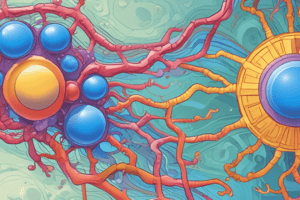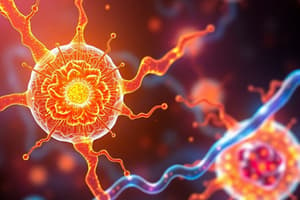Podcast
Questions and Answers
¿Cuál de las siguientes proteínas G es responsable de la activación de la adenilato ciclasa?
¿Cuál de las siguientes proteínas G es responsable de la activación de la adenilato ciclasa?
- Gi
- GPCR
- Gq
- Gs (correct)
¿Cuál es el producto de la hidrólisis del PIP2 por la FLCβ?
¿Cuál es el producto de la hidrólisis del PIP2 por la FLCβ?
- AMPc
- Inositol trifosfato (IP3) y Diacilglicerol (DAG) (correct)
- Proteína quinasa A
- Fosfatidilinositol
¿Qué sucede cuando hay un aumento de la concentración de AMPc intracelular?
¿Qué sucede cuando hay un aumento de la concentración de AMPc intracelular?
- Se inactiva la proteína quinasa A
- Se desencadena una respuesta inflamatoria
- Se aumenta la concentración de Ca+2
- Puede alterar la trascripción de un gen (correct)
¿Cuál es el receptor que se asocia con la vía de señalización de la adenilato ciclasa?
¿Cuál es el receptor que se asocia con la vía de señalización de la adenilato ciclasa?
¿Qué proteína es activada por la AMPc en la vía de señalización de la adenilato ciclasa?
¿Qué proteína es activada por la AMPc en la vía de señalización de la adenilato ciclasa?
¿Cuál es la función de la proteína G inhibitoria en la vía de señalización de la adenilato ciclasa?
¿Cuál es la función de la proteína G inhibitoria en la vía de señalización de la adenilato ciclasa?
¿Cuál es la función del receptor acoplado a proteína G (GPCR) cuando se activa?
¿Cuál es la función del receptor acoplado a proteína G (GPCR) cuando se activa?
¿Cuál es la función de la proteína G en la respuesta a la señal extracelular?
¿Cuál es la función de la proteína G en la respuesta a la señal extracelular?
¿Cuál es el resultado de la unión del ligando al receptor acoplado a proteína G (GPCR)?
¿Cuál es el resultado de la unión del ligando al receptor acoplado a proteína G (GPCR)?
¿Cuál es la característica estructural de los receptores acoplados a proteína G (GPCR)?
¿Cuál es la característica estructural de los receptores acoplados a proteína G (GPCR)?
¿Cuál es el tipo de proteína que constituye la proteína G?
¿Cuál es el tipo de proteína que constituye la proteína G?
¿Cuál es la función de la subunidad α de la proteína G?
¿Cuál es la función de la subunidad α de la proteína G?
¿Cuál es el papel de la proteína G en la señalización de los receptores acoplados a proteína G (GPCR)?
¿Cuál es el papel de la proteína G en la señalización de los receptores acoplados a proteína G (GPCR)?
¿Cuál es el efecto de la toxina del cólera en la señalización de los receptores acoplados a proteína G (GPCR)?
¿Cuál es el efecto de la toxina del cólera en la señalización de los receptores acoplados a proteína G (GPCR)?
¿Cuál es la función de la calmodulina en la respuesta celular a la señal extracelular?
¿Cuál es la función de la calmodulina en la respuesta celular a la señal extracelular?
¿Cuál es el mecanismo de desensibilización de los receptores GPCR?
¿Cuál es el mecanismo de desensibilización de los receptores GPCR?
¿Cuál es el efecto de la activación de la fosfolipasa C β en la respuesta celular?
¿Cuál es el efecto de la activación de la fosfolipasa C β en la respuesta celular?
¿Cuál es la característica principal de los receptores acoplados a enzimas?
¿Cuál es la característica principal de los receptores acoplados a enzimas?
Flashcards
What G protein activates adenylate cyclase?
What G protein activates adenylate cyclase?
Gs protein is responsible for stimulating adenylate cyclase, an enzyme that generates cyclic AMP (cAMP).
What are the products of PIP2 hydrolysis by PLCβ?
What are the products of PIP2 hydrolysis by PLCβ?
Phospholipase C-beta (PLCβ) hydrolyzes phosphatidylinositol 4,5-bisphosphate (PIP2) into two important second messengers: inositol triphosphate (IP3) and diacylglycerol (DAG).
What happens when intracellular cAMP levels rise?
What happens when intracellular cAMP levels rise?
Increased cAMP levels lead to changes in gene expression by activating specific transcription factors.
Which receptor class is associated with the adenylate cyclase signaling pathway?
Which receptor class is associated with the adenylate cyclase signaling pathway?
Signup and view all the flashcards
What protein is activated by cAMP in the adenylate cyclase signaling pathway?
What protein is activated by cAMP in the adenylate cyclase signaling pathway?
Signup and view all the flashcards
What is the function of the inhibitory G protein in the adenylate cyclase signaling pathway?
What is the function of the inhibitory G protein in the adenylate cyclase signaling pathway?
Signup and view all the flashcards
What does a G protein-coupled receptor (GPCR) act as when activated?
What does a G protein-coupled receptor (GPCR) act as when activated?
Signup and view all the flashcards
What is the role of the G protein in the response to an extracellular signal?
What is the role of the G protein in the response to an extracellular signal?
Signup and view all the flashcards
What happens to the G protein-coupled receptor (GPCR) upon ligand binding?
What happens to the G protein-coupled receptor (GPCR) upon ligand binding?
Signup and view all the flashcards
What is the structural feature of G protein-coupled receptors (GPCRs)?
What is the structural feature of G protein-coupled receptors (GPCRs)?
Signup and view all the flashcards
What type of protein constitutes a G protein?
What type of protein constitutes a G protein?
Signup and view all the flashcards
What is the function of the α subunit of the G protein?
What is the function of the α subunit of the G protein?
Signup and view all the flashcards
What role does the G protein play in G protein-coupled receptor (GPCR) signaling?
What role does the G protein play in G protein-coupled receptor (GPCR) signaling?
Signup and view all the flashcards
What effect does cholera toxin have on G protein-coupled receptor (GPCR) signaling?
What effect does cholera toxin have on G protein-coupled receptor (GPCR) signaling?
Signup and view all the flashcards
What is the function of calmodulin in the cellular response to an extracellular signal?
What is the function of calmodulin in the cellular response to an extracellular signal?
Signup and view all the flashcards
What is the mechanism of desensitization of GPCRs?
What is the mechanism of desensitization of GPCRs?
Signup and view all the flashcards
What is the effect of activating phospholipase C β (PLCβ) in the cellular response?
What is the effect of activating phospholipase C β (PLCβ) in the cellular response?
Signup and view all the flashcards
What is the main characteristic of receptor tyrosine kinases (RTKs)?
What is the main characteristic of receptor tyrosine kinases (RTKs)?
Signup and view all the flashcards
Study Notes
Receptores Acompañados a Proteína G (GPCR)
- La unión del ligando induce un cambio conformacional del GPCR que le permite interactuar con una proteína G
- Existen múltiples GPCR, incluso para el mismo ligando (Ej: para adrenalina existen más de 10)
- Responden a una gran variedad de ligandos: hormonas, neurotransmisores, moléculas de adhesión celular, mediadores químicos locales, etc.
Vía de Señalización de la Adenilato Ciclasa
- La proteína G estimulante (Gs) activa la adenilato ciclasa, que cataliza la síntesis de AMPc a partir de ATP
- AMPc activa a la proteína quinasa A (PKA), que posee subunidades regulatorias y catalíticas
- Un aumento de la concentración de AMPc intracelular puede alterar la trascripción de un gen
- CRE: Elemento respuesta a AMPc / CREB: proteína de unión a CRE
Vía de Señalización de la Fosfolipasa C β (FLCβ)
- La FLCβ hidroliza fosfatidilinositol difosfato (PIP2) generando dos productos: Inositol trifosfato (IP3) y Diacilglicerol (DAG)
- IP3 induce la apertura de canales de Ca+2
- DAG actúa sobre la proteína quinasa C (PKC)
Regulación del Ca+2 Intracelular
- La concentración intracelular de Ca+2 afecta la función de proteínas vía calmodulina
- Calmodulina se une y activa mayoritariamente a proteínas Ca+2/calmodulina (CAM) quinasa
- Células eucariotas mantienen concentraciones bajas de Ca2+
- Ca+2 es bombeado desde el citosol al exterior de la célula y al interior del retículo endoplásmático y de la mitocondria
Studying That Suits You
Use AI to generate personalized quizzes and flashcards to suit your learning preferences.




